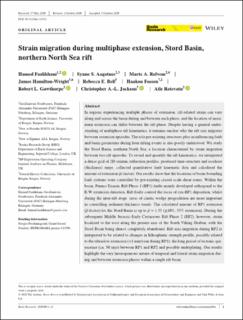| dc.description.abstract | In regions experiencing multiple phases of extension, rift‐related strain can vary along and across the basin during and between each phase, and the location of maximum extension can differ between the rift phase. Despite having a general understanding of multiphase rift kinematics, it remains unclear why the rift axis migrates between extension episodes. The role pre‐existing structures play in influencing fault and basin geometries during later rifting events is also poorly understood. We study the Stord Basin, northern North Sea, a location characterised by strain migration between two rift episodes. To reveal and quantify the rift kinematics, we interpreted a dense grid of 2D seismic reflection profiles, produced time‐structure and isochore (thickness) maps, collected quantitative fault kinematic data and calculated the amount of extension (β‐factor). Our results show that the locations of basin‐bounding fault systems were controlled by pre‐existing crustal‐scale shear zones. Within the basin, Permo‐Triassic Rift Phase 1 (RP1) faults mainly developed orthogonal to the E‐W extension direction. Rift faults control the locus of syn‐RP1 deposition, whilst during the inter‐rift stage, areas of clastic wedge progradation are more important in controlling sediment thickness trends. The calculated amount of RP1 extension (β‐factor) for the Stord Basin is up to β = 1.55 (±10%, 55% extension). During the subsequent Middle Jurassic‐Early Cretaceous Rift Phase 2 (RP2), however, strain localised to the west along the present axis of the South Viking Graben, with the Stord Basin being almost completely abandoned. Rift axis migration during RP2 is interpreted to be related to changes in lithospheric strength profile, possibly related to the ultraslow extension (<1 mm/year during RP1), the long period of tectonic quiescence (ca. 50 myr) between RP1 and RP2 and possible underplating. Our results highlight the very heterogeneous nature of temporal and lateral strain migration during and between extension phases within a single rift basin. | en_US |

